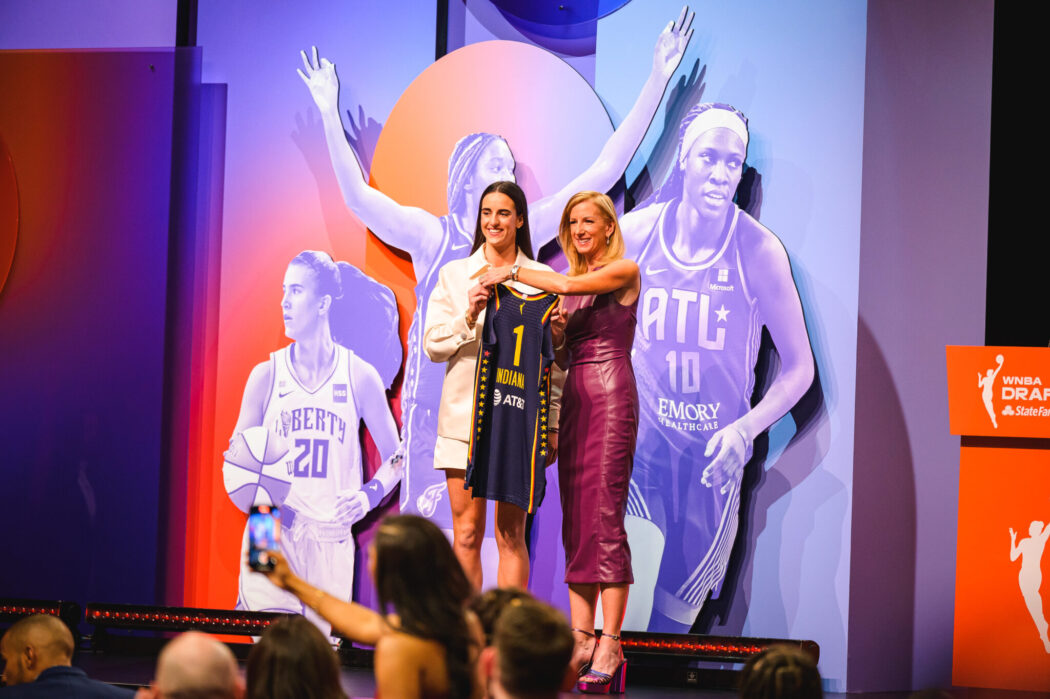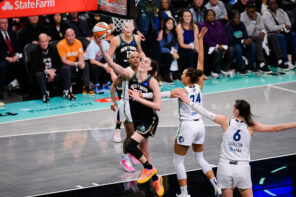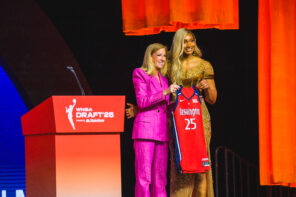One of the unavoidable stories of not only the 2024 WNBA season – but the calendar year that was 2024 was how a legion of racist “fans” attached themselves to Caitlin Clark with the idea that she was the solution to an overly Black women’s basketball landscape.
Clark recently made clear that she is not interested in being part of that “solution” in any way.
With the year 2024 reaching its final days, Time Magazine announced its Athlete of the Year. While there may have been cases for athletes such as Simone Biles, Sha’Carri Richardson, Shedeur Sanders, Travis Hunter or Shohei Ohtani, Time gave No. 22 this year’s nod.
The extensive piece for Time Magazine includes many paragraphs about an unavoidable element of the Clark discourse – how “fans” and media have made this about a white player such as Clark vs. the majority-Black WNBA.
Clark pushed back against those narratives hard in that Time piece.
I want to say I’ve earned every single thing, but as a white person, there is privilege.
–Caitlin Clark, Indiana Fever (per Time Magazine)
A lot of those players in the league that have been really good have been Black players. This league has been built on them. The more we can appreciate that, highlight that, talk about that, and then continue to have brands and companies invest in those players that have made this league incredible, I think it’s very important. I have to continue to try to change that. The more we can elevate Black women, that’s going to be a beautiful thing.
–Caitlin Clark, Indiana Fever (per Time Magazine)
Those comments in that Time piece seem very familiar to when another prominent high-profile white women’s basketball player also used the platform she was given by a mainstream media outlet to push for greater elevation of Black players.
The Time Magazine piece also included reference to when Clark did a “Weekend Update” bit for NBC’s Saturday Night Live which included her thanking five Black women for their contributions to the game. Those five were Lisa Leslie, Dawn Staley, Cynthia Cooper, Maya Moore and Sheryl Swoopes.
Clark thanking Moore is significant because she grew up as a kid in Iowa watching the Minnesota Lynx dynasty of the 2010s. Moore was the reason why Clark even decided to pick up a basketball. Her thanking Swoopes was also significant given the vitriol she received all season from “fans” for her analysis of Clark.
The Saturday Night Live segment occurred prior to the WNBA Draft.
While Clark punctured one narrative in that interview, she also took a baseball bat to another narrative – the idea that there is a rivalry between her and Angel Reese of the Chicago Sky.
We’re not best friends, by any means, but we’re very respectful of one another. Yes, we have had tremendous battles. But when have I ever guarded her? And when has she guarded me?
–Caitlin Clark, Indiana Fever (per Time Magazine)
Clark also mentioned Reese’s John Cena “You Can’t See Me” gesture from the 2023 national championship game between LSU and Iowa.
I didn’t think it was taunting.
–Caitlin Clark, Indiana Fever (per Time Magazine)
It really didn’t bother me. It’s just like, ‘Why don’t you talk about them winning? Or the incredible run that we went on that nobody would have thought we would have ever gone on?’ The only thing people cared about was this controversy that was really fabricated and made up, and then that has continued to be the case ever since.
–Caitlin Clark, Indiana Fever (per Time Magazine)
The Time Magazine article also featured Clark rejecting the notion that she was targeted early in the season by Chennedy Carter, rejecting the notion that the poke in the eye from DiJonai Carrington in Game 1 of the first-round playoff series was intentional and that she should have been on the Olympic team because of the marketing opportunity it would have been for women’s basketball. Clark also felt that Brennan’s line of questioning to Carrington following the incident was inappropriate.
While she wanted to be on the Olympic team, Clark mentions in the piece that she wanted to be on the team because the USA Basketball selection committee felt she was good enough – not because it was a gift.
That Time Magazine piece was recently released – and Clark took a baseball bat to virtually every narrative that has been paraded about her by the mainstream media.
This includes the idea that there is a rivalry between her and Reese. The problem is the WNBA is not helping, Gordo. When the schedule for the 2025 season was released, the Fever and Sky are slated to play each other on five separate occasions – including thrice at Gainbridge Fieldhouse.
That is as much an ESPN call as it is a WNBA call because both WNBA and ESPN want to turn every Clark vs. Reese matchup into LSU vs. Iowa.
Also – Clark clearly gets in that Time Magazine article that her white privilege shields her from plenty of the hate that other players receive. She understands that while she is a great player and is a nucleus of the WNBA’s future, Clark gets that a massive element of her rise is she fits the stereotype of the midwestern “white girl next door.”
Her being a Swiftie certainly helps in that.
Here is our overall takeaway – Clark had every opportunity possible throughout the season and in that interview to pile on and repeat many of the things that the new media was regurgitating about her and other WNBA players. Not only did she not add kerosene to the fire, she doused it with water as if she was working with the Indianapolis Fire Department.
So…where is the coverage?
Where is the non-stop coverage? The mainstream media has had no problem treating every step Clark makes as if it was news. It had no problems covering Clark when she took part in a recent LPGA Pro-Am.
As much as the mainstream sports media loves to milk Clark for views, clicks and phone calls into radio shows, where is the coverage into her comments to Time Magazine?
We know why – because a lot of the same dishonest shock jocks who pushed this false narrative that Black players were jealous of her were the exact shock jocks Clark was talking about when she spoke to Time. And they know it.
Our guess is these folks do not have the intestinal fortitude to go on their radio shows and podcasts and admit they were wrong about how they covered Clark and the WNBA this past season.
Our guess is these folks do not have the intestinal fortitude to admit that their coverage of the WNBA should have been no different from the NBA, MLB or any other male sport. Instead, they tried to create a hero vs. villain movie plot when there was no movie.
Our guess is these folks do not have the intestinal fortitude to go on their radio shows and/or podcasts and admit they should have had esteemed journalists such as Ari Chambers, Terrika Foster-Brasby, Myles Ehrlich and Khristina Williams on their platforms to talk WNBA.
A lot of these individuals and entities are trying to create this falsified, almost AI-generated version of what they want Clark to be. Then – there is the real Clark as she displayed in that interview with Sean Gregory at Time Magazine.
When the 2025 season tips off, hopefully the narratives about Clark will be more about her greatness on the court instead of all of the “other stuff.” The Indiana Fever now have real championship aspirations and will almost certainly establish themselves as part of the WNBA’s elite teams for the next 15 years with Clark and Aliyah Boston as part of its nucleus.
There is a better-than-decent chance we could see the Fever in the next several years bring a WNBA championship to the Hoosier State for the first time since 2012. And, perhaps, Clark would take a large step in becoming (for real) the face of the WNBA.
All of the aforementioned are the stories we should be talking about in regards to Clark – if only (and she seems to agree) the mainstream sports press would learn to be journalists instead of Hollywood scriptwriters.




